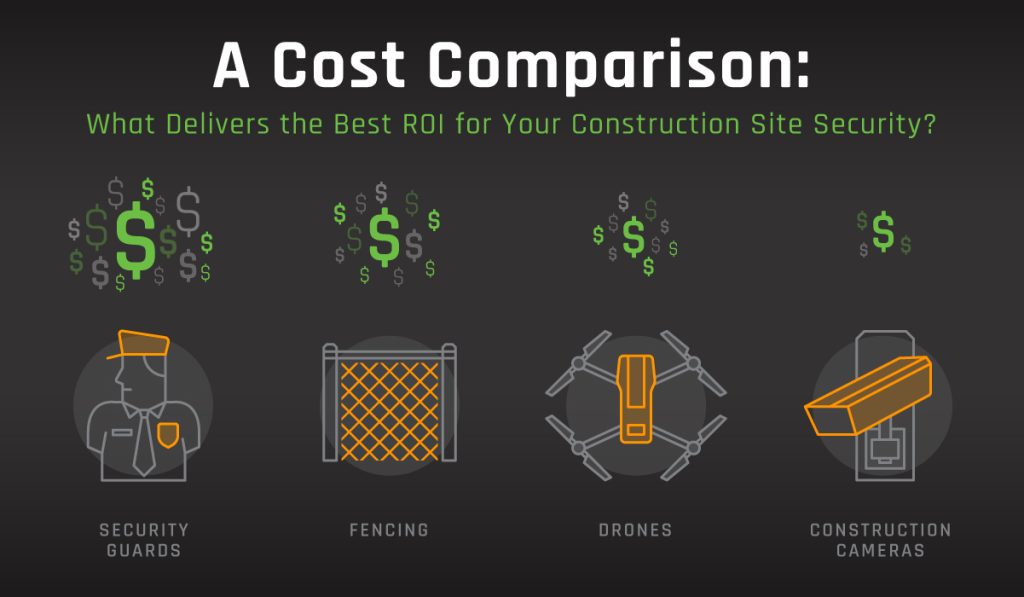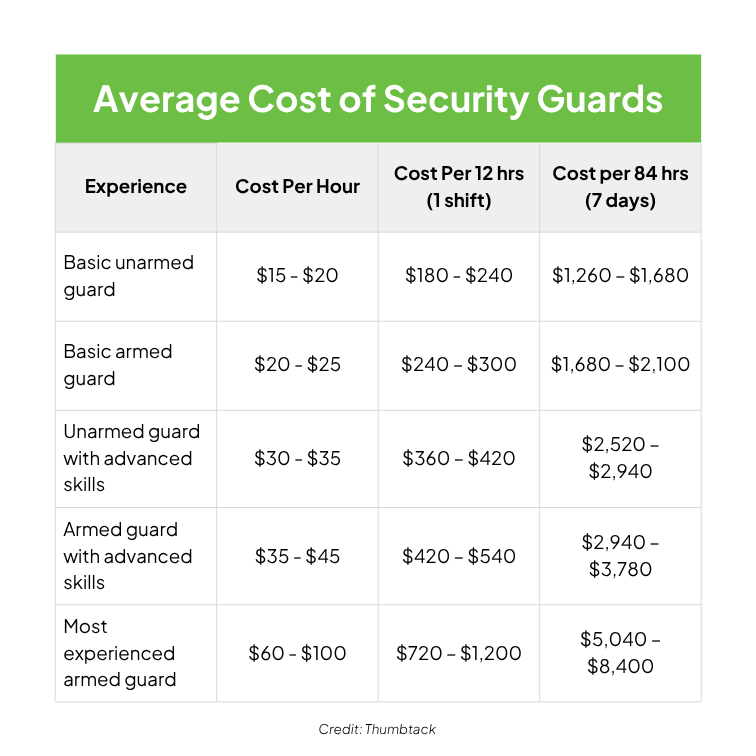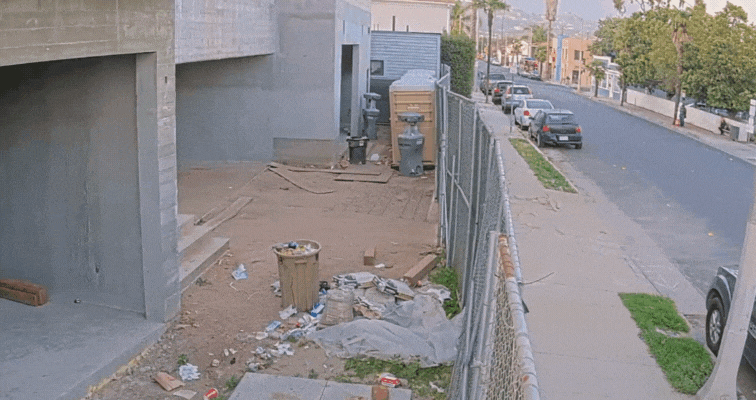
Each year, thieves take between $300 million and $1 billion of construction equipment from jobsites nationwide. According to a 2019 study, the average incident costs contractors around $6,000, with trucks representing an average cost of $42,000 per incident.
What’s worse is that most of the equipment, materials, and vehicles stolen are never to be seen again, with only 7% recovered annually. Stolen equipment not only strains a firm’s budget, but it can also cause project delays and impact client satisfaction.
It’s clear that not having any construction site security is too great a risk to take. Ideally, a layered security approach combines technology and human presence for maximum security, but that is an expensive endeavor.
That’s why we’ve put together this guide to walk you through construction site security guard costs and the ROI of various security measures. Think you can’t afford security? Think again, because we show how cameras pay off quickly, especially when compared with the alternatives.
The Cost of Traditional Security Measures
Protecting your construction projects from theft requires effective security measures, but traditional options often increase costs for contractors significantly. Knowing the true cost efficiency and return on investment of security guards, temporary fencing, and newer technologies is a must before dropping massive amounts of money on protection for your valuable equipment and materials.
Security Guards
An on-site security guard can intervene immediately when an incident occurs. However, that convenience comes with a hefty fee: A year’s worth of round-the-clock surveillance will cost you about $525,000, and that’s assuming you only have one guard on-site at a time.
The average cost of a construction site security guard runs $19.44 an hour. Depending on their experience and whether or not you opt for armed security guards, that rate could be much higher. Of course, full-time guards will require benefits, like healthcare and paid time off, and both full and part-time guards will require training.

The more guards you need per project, the more significant the investment is for you and your client. Besides the high cost, there are additional drawbacks to using construction site security guards to protect the jobsite:
- A guard has limited visibility and must walk around the site to ensure all is well. For large sites, this is inefficient.
- Guards are susceptible to harm, and their presence may not dissuade persistent criminals.
- There is additional overhead involved with managing on-site security guards. Someone on your staff has to organize their hours and payment, and make alternative arrangements should security personnel call in sick or fail to show up for work.
- A construction site security guard can only do one thing: Watch the jobsite. If an incident occurs, there may not be any evidence other than their personal account of the situation, which makes police investigations or insurance claims challenging and potentially less effective.
Fencing
To deter thieves, most construction firms put up temporary fencing as a first line of defense. However, fencing can get very expensive, particularly for larger sites.
For example, the most entry-level orange security fencing from Home Depot runs around $40 per 100-foot roll. Yet, these fences are far from protective physical barriers. Pricing for renting a temporary fence can cost between $60 and $1000 per panel. However, costs vary wildly depending on your area, the type of fencing (gated, mesh, anti-climb, wrapped, in-ground, chain, etc.), and the length of time you need it.
Unfortunately, temporary fencing alone does not deter theft or vandalism; it’s easy for criminals to hop over a six-foot fence, sneak through a bend in the fence, or even sneak underneath a fence.

What’s more, fencing doesn’t prevent insider theft, which can add up to significant losses. Cameras can help prevent issues like employees being paid for unworked time, which can cost construction firms tens of thousands of dollars annually.
Security Drones
Drones are the hottest and latest security service in the world of construction security. Surveillance drones are popular because they can view locations humans don’t usually get to see and act as mobile camera platforms. As tech evolves, AI can pilot platforms on pre-described routes, with or without a pilot.
However, drones are far from cheap. In fact, drones are one of the most costly investments you can make as far as security goes. Low-end drone models start at $7,000 and require a hands-on operator. Those operators charge by the hour; some charge as low as $25 an hour, while others can stretch into the hundreds of dollars an hour.
Operating a drone like this easily costs $52,000 a year, but with additional equipment, like batteries to keep it in flight, maintenance, downtime, and operational costs, expect to spend several thousand more. In extreme cases, a drone can cost $250,000 a year to operate!
Another catch is that it’s physically impossible to have 24/7 surveillance with one drone, as you must recharge periodically. Security firms usually operate multiple drones for full-time surveillance, adding to your costs.
The Smart Investment: ROI of Construction Cameras
Construction cameras are arguably the best way to implement reliable construction site security, and they’re cost-effective when compared to other methods. Advanced construction cameras range from $1,000 to $9,000, depending on the capabilities. Monthly subscription fees can range from $99 to $600 per month. Therefore, a single high-end camera setup, including a year of subscription fees, could cost up to $16,200 annually.
Contractors have a wide range of options, including fixed-position cameras, pan-tilt-zoom cameras with robotic 360-degree capabilities, mobile surveillance trailers, and more. Many offer HD photos and video at 1080p or better for clear, high-quality images, and the ability to change the camera’s angle remotely to get a better view.
Some advanced camera providers, like TrueLook, even offer Intelligent Security features, which can detect motion after hours and trigger customized alerts.
A primary advantage of construction cameras is their 24/7 recording capability. This continuous footage provides a comprehensive record, allowing you to thoroughly review incidents, understand events, and easily retrieve video evidence when necessary.
Timely alerts allow you to quickly notify the police and potentially prevent the intruder from making away with your property. After the incident, you benefit from full visual evidence that helps with police investigations and insurance claims.
For enhanced security, TrueLook’s Jobsite Monitoring service includes a dedicated team that can actively watch your site’s camera feeds after hours, verify potential threats, and dispatch the police on your behalf.
Overall, strategically placed cameras can also deter insider theft and other unauthorized activities on the jobsite.
Cost Considerations and Camera Options
Fixed-position cameras offering sharp HD images with advanced digital zoom capabilities start at around $1,000. Pan-Tilt-Zoom (PTZ) cameras provide remote 360-degree control and typically start at around $4,000, making them ideal for larger construction projects where coverage of multiple areas is essential.
Mobile camera trailers and interior multi-camera units further provide flexible security solutions for temporary or changing jobsite locations, with costs varying based on configuration and mobility requirements. Comprehensive security offerings that combine surveillance cameras with AI-driven monitoring, strobes, and sirens may represent a higher initial investment but deliver superior theft prevention and access control benefits.
Subscription fees for surveillance cameras can range from $99 to $600 monthly, covering cellular connectivity, cloud storage, and features such as remote live viewing, motion detection, and progress documentation. Solar-powered options can reduce operational costs over time by eliminating the need for continuous power connections, though they generally require a higher initial investment than standard 110V security cameras.
Many contractors opt for leasing rather than purchasing, eliminating upfront payments and spreading the cost over monthly installments for shorter-term construction projects. For long-term contracts or companies with continuous security needs across multiple construction sites, purchasing becomes more cost-effective by reducing monthly costs after the initial equipment investment.
Quantifiable Construction Site Camera Benefits and ROI
Construction cameras deliver substantial return on investment through multiple avenues beyond basic security functions.
- Theft and Vandalism Prevention: A study from The Economic Journal found a 25% reduction in crime as a result of security cameras. Visible surveillance cameras act as powerful deterrents to criminal activity, protecting valuable equipment and materials from theft and vandalism on construction sites.
- Reduced Insurance Costs: Insurance providers often recognize security camera systems as risk-reduction measures, potentially leading to more favorable premium rates and providing essential documentation for processing claims.
- Prevention of Project Delays: Project delays caused by theft or vandalism can significantly impact budgets, but motion detection technology with night vision capabilities helps prevent these incidents through early detection and response.
- Improved Site Oversight and Efficiency: Project managers gain significant efficiency through remote live site viewing, eliminating travel time and expenses while enabling real-time decision-making without a physical presence on larger sites.
- Improved Documentation for Disputes and Claims: When disputes arise with subcontractors or clients, archived footage provides irrefutable evidence of work completion, material deliveries, and site conditions, often preventing costly legal battles.
- Time-Lapse for Marketing and Progress Tracking: Automated picture collection throughout your project eliminates the scheduling headache and expense of hiring photographers, videographers, or drone pilots, while creating professional time-lapse marketing content that showcases your expertise.
The technology investment in construction cameras pays for itself quickly through these combined benefits, making it significantly more cost-effective than relying solely on traditional security personnel or physical barriers.
Head-to-Head: Security Guards vs. Construction Cameras
When comparing construction site security options, the cost efficiency and effectiveness of various security measures reveal striking differences in overall return on investment.


TrueLook performed an in-depth ROI analysis of construction cameras and determined that a $14,000 initial investment in cameras can deliver a conservative ROI of 226.43% and a $31,700 investment gain in just 10 months. The total estimated savings (excluding the massive savings of reducing inefficiencies) add up to $45,700.
While drones provide aerial surveillance and armed guards offer physical presence, the value exchange for the investment in these solutions is less than desirable. A single guard costs approximately $19.44 per hour, resulting in annual expenses exceeding $170,000 for 24/7 coverage. In contrast, surveillance cameras operate continuously at a fraction of the cost with no breaks or labor costs.
Human security personnel face inherent limitations, including fatigue, blind spots on larger sites, and potential for distraction, while cameras provide constant vigilance across multiple areas simultaneously. Additionally, ex-military or private investigators hired for executive protection may increase costs significantly compared to unarmed guards, making the total cost of human security prohibitive for many businesses.
Construction site security is at its best when you use cameras, as they provide tremendous additional cost savings in the following areas, offsetting the initial investment:
- Compliance: With cameras surveying worker and subcontractor behavior, people on your jobsite are more likely to follow regulations and policies. Additionally, photos and videos provide evidence of compliance should your firm be subject to an audit.
- Injury prevention: Cameras can enforce safety regulations that protect workers, and project managers can view jobsite activity remotely to spot and address potential safety hazards early, before there’s an accident.
- Productivity: Knowing that cameras are present on the job site has been shown to increase worker productivity and efficiency. This increased productivity can help you complete projects faster and reduce several factors that typically increase costs.
- Marketing: Besides providing security, construction cameras create construction time-lapses, before and after photos, 360-degree panoramic photos, and other visuals to enhance digital or printed promotional materials for your security firm or construction company.
For long-term contracts and ongoing project management, the security solution offering the highest return while addressing potential threats clearly favors technology over security personnel.
The Optimal Security Strategy: A Layered Approach
If you have the budget, the best approach is a combination of cameras and a guard, though cameras alone offer superior cost efficiency for construction projects with limited budgets. The security solution with the highest ROI combines technological surveillance with human intervention to create a comprehensive system where each component strengthens the other while addressing various potential threats.
Here’s how the human guards and advanced cameras work together:
- Security guards offer immediate intervention if suspicious activity occurs, responding directly to prevent damage.
- Cameras continuously record high-quality footage, providing irrefutable evidence for insurance claims or legal proceedings.
- Guards stationed at strategic points like entrances or access control areas visibly deter criminals from approaching.
- Guards can respond to alerts generated when cameras detect unauthorized movement in remote areas of larger sites.
- Cameras provide crucial context for guard interventions, documenting incidents completely.
- Cameras cover areas that would require several guards to patrol continuously, significantly reducing labor costs and hourly rates.
- While guards require breaks and may occasionally miss shifts, surveillance cameras run 24/7 with night vision capabilities.
- Integrated camera systems can trigger automatic alerts to police in real-time when connected to a monitoring service.
For truly comprehensive protection, deploy temporary fencing to establish a defined perimeter, then use occasional drone surveillance for aerial monitoring. This multi-faceted approach addresses security needs from multiple angles, ensuring that even if one system fails, other measures remain active to protect valuable equipment and prevent criminal activity.
Investing Wisely in Construction Site Security
By providing reliable surveillance, visual evidence of incidents for compliance audits and investigations, and a host of additional benefits, construction cameras are the best option for construction site security.
Ready to learn more? View an overview of the TrueLook platform or book a time to get your questions answered by a member of the team.

